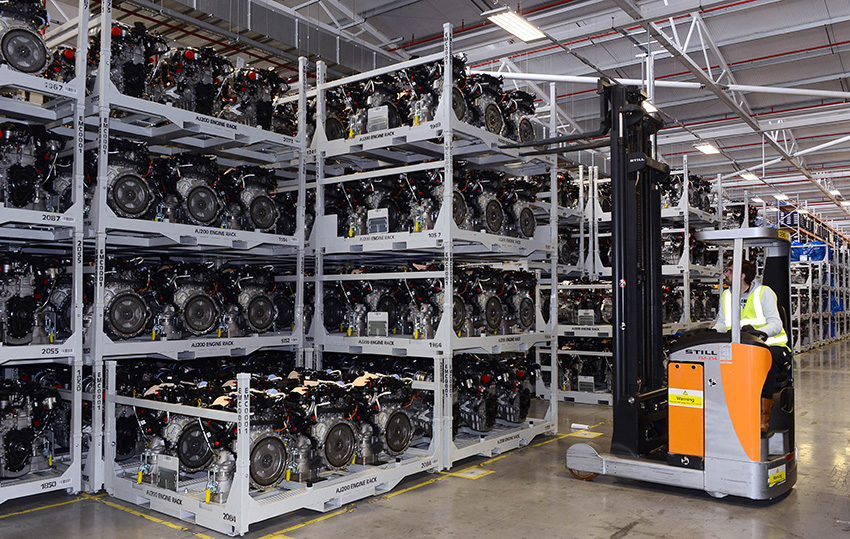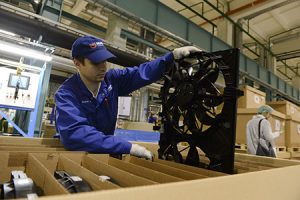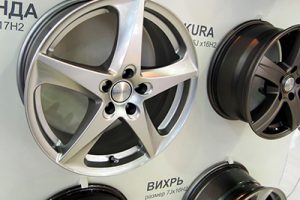OEMs and tier suppliers in Russia have plans to support their flagging domestic business with more components exports
 With vehicle assembly in Russia operating well below capacity, over the past two years carmakers have tried to increase vehicle exports to other regions, including eastern Europe, the Middle East and Latin America. Recently, a number of OEMs in Russia have also been authorising their tier suppliers there to export components to assembly and aftermarket sales operations abroad.
With vehicle assembly in Russia operating well below capacity, over the past two years carmakers have tried to increase vehicle exports to other regions, including eastern Europe, the Middle East and Latin America. Recently, a number of OEMs in Russia have also been authorising their tier suppliers there to export components to assembly and aftermarket sales operations abroad.
Industry analyst PwC estimates that overall demand for automotive components in Russia has declined 44% in the last two years, a steeper drop than in vehicle assembly.
In this story...
Amid this falling internal market, tier suppliers have cut capacities and laid off staff, among other measures. Increasing exports could help some to keep the lights on.
Market observers point out that vehicle and parts exports would be good for Russia’s automotive logistics sector, as it would help provide much-needed return loads for carriers entering the country. “More return loading for freight arriving in Russia would have a positive impact on the cost of transport,” says Andrey Gryazev, sales and marketing director at logistics provider Agility.
Gryazev points out that current exchange rates and market conditions are favourable in terms of encouraging more exports. “After the devaluation of the rouble, prices for goods produced in Russia fell in international markets – hence, the growth taking place in exports in the automotive industry,” he says. “Along with Russian producers, international manufacturers of automotive components who have localised production in Russia are benefitting from this trend.”
[sta_anchor id="1"]However, just as Russian plants cannot easily switch models to serve other markets, neither can tier suppliers. There are not many markets these suppliers can realistically serve, while OEMs in the country already struggle to localise parts. Nevertheless, plans are starting to emerge for carmakers and tier suppliers to ship parts from Russia to other markets, even if the logistics services to support them so far remain unclear.
Russia – a local, faster source?Carmakers such Ford-Sollers and Renault Nissan are among those targeting growth in parts shipments. Hau Thai-Tang, Ford’s group vice-president for global purchasing, confirms that the OEM wants to increase the number of tier one suppliers authorised to export from Russia from just three at the moment to around 20 by 2019, or around 30% of the total it uses in Russia.
Ford-Sollers says most export supplies will be aimed at its plants in Europe, including Germany, Romania and the UK, in some cases replacing components from further afield, such as from India.
Many components will go to Ford’s Craiova factory in Romania, where it is due to begin assembly of the EcoSport compact SUV in September 2017. Ford currently sells 40,000 EcoSport units across Europe, all built in Chennai, India.

The carmaker’s existing component exports from Russia comprise alloy wheels (made by Skad), brackets (ZMZ) and spark plugs (Bosch), which are used at plants in Germany and the UK. Ford plans to add six more firms including those producing interior parts (Faurecia and Magna), stampings (Soskunoz and Peterform), glass products (AGC) and seals. The plan is then to move on to suppliers producing metal and plastic components, Thai-Tang confirms, though neither he nor the company will reveal how the logistics of such deliveries will take place.
However, the feasibility of export supplies is based on geographical proximity to Russia and on the pool of certified Russian suppliers. Thai-Tang confirms that there are now 23 tier one suppliers in Russia with ‘Q1’ status, which means they comply fully with Ford’s global supplier requirements.
Renault and Nissan also intend to ramp up component exports. Andrey Pankov, director of Renault Russia, says the volume of Renault’s parts exports in 2016 from Russia was expected to reach $27.2m – itself 70% more than in 2014 – while in 2017, it should reach around $50m. Renault has recently reached an agreement covering this increase with nearly 20 tier one suppliers in Russia; in 2017, it will conduct deliveries of components and spare parts to 16 different countries. Romania will account for nearly 20% of the total, and Turkey and Latin America for 10% each. It will also export to new markets including Algeria and Vietnam. The carmaker is not prepared to discuss logistics arrangements yet.
Since September, components exports have also been established by Nissan’s St Petersburg plant, with front and rear bumpers for the X-Trail SUV shipped to its warehouse in Amsterdam, in the Netherlands, according to a spokesperson. Such exports will help Nissan lower logistics costs by replacing bumpers previously delivered from Japan.
During 2017, Nissan may export as many as 6,000 bumpers to Europe, a figure it expects to rise to 10,000. Bumpers are produced from granulate supplied to St Petersburg from the Netherlands and the company is evaluating the possibility of adding some metal components to its list of exports, according to the spokesperson.
Meanwhile, PSA Group spokesperson Marina Stepina says the carmaker’s plant in Kaluga, south of Moscow, already exports components for servicing and maintenance of the vehicles it exports to Belarus, Ukraine, Kazakhstan and Moldova, including stampings, glass, bumpers, headlights, taillights and wheel arches.
The carmaker is also looking at supplying Russian spare parts for models not made at Kaluga, she confirms. Several projects are in development, the first of which is scheduled for early 2017 and involves supplying headlights made by Automotive Lighting in Europe for a Peugeot model.
At the time of writing, Stepina says the PSA Group is still working on its logistics network for such exports and cannot provide specifics.
Avtovaz has also confirmed ambitions to export parts to Europe and Asia, says a spokesperson, with the latter perhaps taking place by land via Kazakhstan and Mongolia.
Some reports have also suggested that Volkswagen is considering exports of car bodies to Europe, but a spokesperson says the company is not currently exporting any components from Russia.
In 2018, meanwhile, Mazda will produce its SkyActiv-G engines in a joint venture with Sollers in Vladivostok, in the far east of Russia. Although Mazda-Sollers assembles vehicles here, the 50,000 engines Mazda plans to produce will be allocated entirely for export, primarily to Japan and elsewhere in Asia, a Mazda-Sollers spokesperson explains. The type of engine to be built here will be universal and can be installed on almost all the company’s models.
[sta_anchor id="2"]The move will help Mazda cut its spend on global logistics, since it will be implemented in a special economic zone with a favourable tax regime and other government support, according to the spokesperson, who also cites lower labour costs than that of most Asian countries. Vladivostok is an important transport hub with well-developed port infrastructure, so engines could easily be supplied to other assembly operations in the Asia Pacific region.
 Russia's government has not done much to encourage exports of automotive components so far but a new strategy being developed may change that
Russia's government has not done much to encourage exports of automotive components so far but a new strategy being developed may change thatGovernment supportGovernment subsidies often play an important role in Russia’s automotive supply chain. During 2016, the government set aside nearly 50 billion roubles ($800m) of state support for carmakers, including 3.3 billion to reimburse them for the logistics costs involved in moving finished vehicles within Russia. The Industry and Trade Ministry has actively encouraged exports with funding to support vehicles. So far, however, there has been little explicit government support for automotive components.
According to Wilhelmina Shavshina, head of the foreign trade regulation practice at law firm DLA Piper, in September the Russian government adopted decree number 905, which subsidises part of manufacturers’ export costs, including transport, homologation and compliance with international vehicle standards. “But according to components manufacturers, this bill is not really about them, and stipulates a number of criteria that cannot be achieved by them, in contrast to car manufacturers,” she says.
“The Russian Ministry of Industry and Trade is, however, developing its Strategy of Automotive Industry Development for the period up to 2025. We believe this may contain a number of other export support measures,” adds Shavshina.
However, there is leeway within the Russian custom tariffs regime that could be used by manufacturers to save on logistics costs.
“The customs control system [in Russia] provides certain features that encourage localised production in Russia for export purposes. They include the procedures for operations on customs territory and a special customs zone, which provides exemption from customs payments when importing raw materials and exporting finished goods from Russia,” says Shavshina, who adds that non-resource exports in Russia are not subject to any export tax.
[sta_anchor id="3"]There are practical hurdles involved, such as the rules relating to permits, reporting and the volume of foreign goods present in finished products, “but some companies are using [these mechanisms] to obtain a significant economic impact,” she says.
Barriers to entryEven if costs from Russia could be supported, suppliers exporting their wares may face difficulties in other countries, say some market participants. Many countries have already created artificial barriers against Russian imports in the shape of high customs duties, points out Alexandr Gorchakov, deputy director general for strategic development at the Russian state scientific centre, FGUP NAMI.
 Russia's customs regime does provide some encouragement for localised production of components for export purposes
Russia's customs regime does provide some encouragement for localised production of components for export purposes“There is a risk, when exporting automotive components branded ‘made in Russia’, that more protectionist restrictions may be introduced in some destination countries,” adds Agility’s Andrey Gryazev. “This issue should be resolved between the ministries of those consumer countries and the producers, so that any barriers facing Russian goods are broken down.”
The quality of Russian products made to international standards under proper control is not inferior to foreign ones, Gryazev adds. Export potential should encourage logistics providers to develop new delivery services for the supply of components internationally from Russia, he suggests. So far, however, many providers have yet to notice any real rise in component export flows.
Gefco, in particular, suggests the trend may only just be picking up pace. “In our clients’ portfolios we have not noticed any significant changes in the structure of the component streams. Many Russian component manufacturers are only just starting to think about how to expand their sales markets,” confirms Nikita Pushkarev, commercial [sta_anchor id="4"]director of Gefco Russia. “Manufacturers tend to prioritise the markets of the CIS countries – like Kazakhstan, Belarus, and Armenia – and few of them are aware of the potential support options for subsidising the logistics costs of export [elsewhere].”
 So far, most international tier suppliers in Russia have remained quiet about their export plans. However, Russian wheel supplier Skad says it will expand exports, which already make up 40% of its current sales, to nearly 20 countries in west and eastern Europe, Kazakhstan, and as far afield as Panama.
So far, most international tier suppliers in Russia have remained quiet about their export plans. However, Russian wheel supplier Skad says it will expand exports, which already make up 40% of its current sales, to nearly 20 countries in west and eastern Europe, Kazakhstan, and as far afield as Panama.
Skad, which began exports in 2012 and is the only Russian company authorised to supply alloy wheels to Europe, has also begun exploring projects for the supply of alloy wheels to the US, Finland and Norway.
With a planned production volume of 1.5m wheels in 2017, the company supplies assembly plants run by Ford, Mitsubishi, Peugeot-Citroën, Volkswagen and Toyota.
Alexey Chekhvalov, Skad’s chief commercial officer, admits that the firm’s geographical location is a logistics challenge – its plant lies right in the heart of Siberia, far from Europe and Russian ports. Despite this, the company can supply Europe faster than Asia, he says, with competitive prices.





































